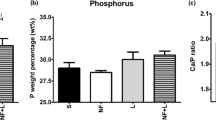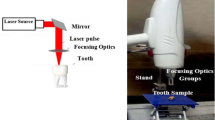Abstract
A combination of atomic absorption spectroscopy (AAS), Fourier transform infrared spectroscopy (FTIR), scanning electronic microscopy (SEM), and gas adsorption techniques was used to characterize the effect of 30 % hydrogen peroxide (HP) on enamel surface. To perform the analyses of AAS, 1 ml of 30 % HP was added to 30 mg of a bovine enamel powder sample (150–200 µm fractions) for times of 5, 20, 60, 90, and 120 min; then 5 ml of the solution was withdrawn after each time period to measure [Ca2+] ions. The remaining powder was recovered and analyzed by FTIR. For SEM and gas adsorption tests, 4 × 4 mm2 enamel sectioned samples were polished and 30 % HP was applied on the surface for the same time periods. AAS data show that 30 % HP treatment mobilized calcium from the enamel at all times studied. FTIR spectra showed that the total amount of phosphate and carbonate mineral contents such as amide I decreased significantly. SEM revealed that randomly distributed areas throughout the smooth enamel surface treatment became rougher and more irregular. These alterations indicate that surface damage increases with increasing durations of HP treatment. Gas adsorption analysis proved that bleached enamel is a typically non-porous material with a small specific surface area which decreases slightly with the 30 % HP treatment. In sum, 30 % HP induced a significant alteration of the organic and mineral part of the enamel, leading to the release of calcium and a rougher, more irregular enamel surface on randomly distributed areas.





Similar content being viewed by others
References
Kawamoto K, Tsujimoto Y. Effects of the hydroxyl radical and hydrogen peroxide on tooth bleaching. J Endod. 2004;30:45–50.
Götz H, Duschner H, White DJ, Klukowska MA. Effects of elevated hydrogen peroxide ‘strip’ bleaching on surface and subsurface enamel including subsurface histomorphology, micro-chemical composition and fluorescence changes. J Dent. 2007;35:457–66.
Efeoglu N, Wood D, Efeoglu C. Microcomputerised tomography evaluation of 10 % carbamide peroxide applied to enamel. J Dent. 2005;33:561–7.
Joiner A. The bleaching of teeth: a review of the literature. J Dent. 2006;34:412–9.
Goldberg M, Grootveld M, Lynch E. Undesirable and adverse effects of tooth-whitening products: a review. Clin Oral Investig. 2010;14:1–10.
Bistey T, Nagy IP, Simó A, Hegedus C. In vitro FTIR study of the effects of hydrogen peroxide on superficial tooth enamel. J Dent. 2007;35:325–30.
Severcan F, Gokduman K, Dogan A, Bolay S, Gokalp S. Effects of in-office and at-home bleaching on human enamel and dentin: an in vitro application of Fourier transform infrared study. Appl Spectrosc. 2008;62:1274–9.
Santini A, Pulham CR, Rajab A, Ibbetson R. The effect of a 10 % carbamide peroxide bleaching agent on the phosphate concentration of tooth enamel assessed by Raman spectroscopy. Dent Traumatol. 2008;24:220–3.
Buchalla W, Attin T. External bleaching therapy with activation by heat, light or laser: a systematic review. Dent Mater. 2007;23:586–96.
Hannig C, Hamkens A, Becker K, Attin R, Attin T. Erosive effects of different acids on bovine enamel: release of calcium and phosphate in vitro. Arch Oral Biol. 2005;50:541–52.
Zantner C, Beheim-Schwarzbach N, Neumann K, Kielbassa AM. Surface microhardness of enamel after different home bleaching procedures. J Dent Res. 2007;23:243–50.
Sun L, Liang S, Sa Y, Wang Z, Ma X, Jiang T, Wang Y. Surface alteration of human tooth enamel subjected to acidic and neutral 30 % hydrogen peroxide. J Dent. 2011;39:686–92.
Sulieman M, Addy M, MacDonald E, Rees JS. A safety study in vitro for the effects of an in-office bleaching system on the integrity of enamel and dentine. J Dent. 2004;32:581–90.
Rodríguez Navarro AB, Romanek CS, Alvarez Lloret P, Gaines KF. Effect of in ovo exposure to PCBs and Hg on clapper rail bone mineral chemistry from a contaminated Salt Marsh in Coastal Georgia. Env Sci Tech. 2006;40:4936–42.
Sing KSW, Everett DH, Haul RW, Moscou L, Rapierotti RA, Rouquerol J, Siemieniewska T. Reporting physisorption data for gas solid systems with special reference to the determination of surface-area and porosity (recommendations 1984). Pure Appl Chem. 1985;57:603–19.
Adamson AW, Gast AP. Physical chemistry of surfaces. 6th ed. New York: Wiley; 1997.
Gregg SJ, Sing KSW. Adsorption, surface area and porosity. London: Academic Press; 1982.
Reis AF, Giannini M, Kavaguchi A, Soares CJ, Line SR. Comparison of microtensile bond strength to enamel and dentin of human, bovine, and porcine teeth. J Adhes Dent. 2004;6:117–21.
Wang X, Mihailova B, Klocke A, Fittschen UE, Heidrich S, Hill M, Stosch R, Güttler B, Broekaert JA, Bismayer U. Side effects of a non-peroxide-based home bleaching agent on dental enamel. J Biomed Mater Res A. 2009;88:195–204.
Al-Salehi SK, Wood DJ, Hatton PV. The effect of 24 h non-stop hydrogen peroxide concentration on bovine enamel and dentine mineral content and microhardness. J Dent. 2007;35:845–50.
Lee KH, Kim HI, Kim KH, Kwon YH. Mineral loss form bovine enamel by a 30 % hydrogen peroxide solution. J Oral Rehabil. 2006;33:229–33.
Sato C, Rodrigues FA, Garcia DM, Vidal CM, Pashley DH, Tjäderhane L, Carrilho MR, Nascimento FD, Tersariol IL. Tooth bleaching increases dentinal protease activity. J Dent Res. 2013;92:187–92.
Ubaldini AL, Baesso ML, Medina Neto A, Sato F, Bento AC, Pascotto RC. Hydrogen peroxide diffusion dynamics in dental tissues. J Dent Res. 2013;92:661–5.
Park HJ, Kwon TY, Nam SH, Kim HJ, Kim KH, Kim YJ. Changes in bovine enamel after treatment with a 30 % hydrogen peroxide bleaching agent. Dent Mater J. 2004;23:517–21.
Sa Y, Chen D, Liu Y, Wen W, Xu M, Jiang T, Wang Y. Effects of two in-office bleaching agents with different pH values on enamel surface structure and color: an in situ vs. in vitro study. J Dent. 2012;40(Suppl 1):e26–34.
Jiang T, Ma X, Wang Y, Tong H, Shen X, Hu Y, Hu J. Investigation of the effects of 30 % hydrogen peroxide on human tooth enamel by Raman scattering and laser-induced fluorescence. J Biomed Opt. 2008;13:014019.
Zimmerman B, Datko L, Cupelli M, Alapati S, Dean D, Kennedy M. Alteration of dentin-enamel mechanical properties due to dental whitening treatments. J Mech Behav Biomed Mater. 2010;3:339–46.
Fattibene P, Carosi A, De Coste V, Sacchetti A, Nucara A, Postorino P, Dore P. A comparative EPR, infrared and Raman study of natural and deproteinated tooth enamel and dentin. Phys Med Biol. 2005;50:1095–108.
Cazalbou S, Combes C, Eichert D, Rey C, Glimcher MJ. Poorly crystalline apatites: evolution and maturation in vitro and in vivo. J Bone Miner Metab. 2004;22:310–7.
Amaechi BT, Higham SM, Edgar WM. Factors influencing the development of dental erosion in vitro: enamel type, temperature and exposure time. J Oral Rehabil. 1999;26:624–30.
Park S, Wang DH, Zhang D, Romberg E, Arola D. Mechanical properties of human enamel as a function of age and location in the tooth. J Mater Sci Mater Med. 2008;19:2317–24.
Ushigome T, Takemoto S, Hattori M, Yoshinari M, Kawada E, Oda Y. Influence of peroxide treatment on bovine enamel surface—cross sectional analysis. Dent Mater J. 2009;28:315–23.
Nguyen TT, Miller A, Orellana MF. Characterization of the porosity of human dental enamel and shear bond strength in vitro after variable etch times: initial findings using the BET method. Angle Orthod. 2011;81:707–15.
Acknowledgments
Funding was obtained from projects CGL2011-25906 and UNOV-13-EMERG-08.
Conflict of interest
The authors declare that they have no conflict of interest.
Author information
Authors and Affiliations
Corresponding author
Rights and permissions
About this article
Cite this article
González-López, S., Torres-Rodríguez, C., Bolaños-Carmona, V. et al. Effect of 30 % hydrogen peroxide on mineral chemical composition and surface morphology of bovine enamel. Odontology 104, 44–52 (2016). https://doi.org/10.1007/s10266-014-0189-7
Received:
Accepted:
Published:
Issue Date:
DOI: https://doi.org/10.1007/s10266-014-0189-7




